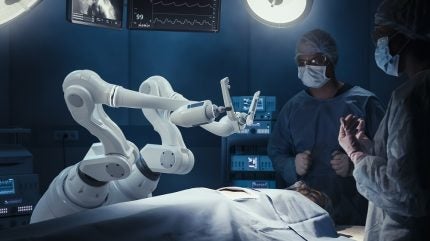
Imagine a surgeon performing a delicate heart procedure with the precision of a jeweller, all while sitting comfortably at a console several feet, or even miles, away from the patient. This is not a scene from a futuristic science fiction film, but a reality unfolding in operating rooms today.
According to GlobalData, in 2022, the surgical robotics market was worth $8.6bn and is projected to reach $10bn globally by the end of 2024. The market is expected to grow at a compound annual growth rate (CAGR) of 8% to reach $15.8bn by 2030, suggesting a steady growth trajectory.
This rise in robotic surgery is breaking down barriers to accessing specialised medical treatment for heart conditions. Notably, remote telesurgery is enabling experienced surgeons to conduct operations from a distance, guiding and assisting their colleagues in regions where advanced medical facilities are scarce.
The world’s first remote heart surgery was carried out in India in 2019. According to a study published in The Lancet’s EClinicalMedicine, this technology could be deployed “as a front-line service in regions where such expertise is not available,” if paired with “improvements in network connectivity,” such as 5G.
Robot-assisted heart surgery vs traditional methods
Robotic-assisted heart surgery employs advanced robotic systems, such as the da Vinci Surgical System, to perform complex cardiovascular procedures. These systems are designed to provide surgeons with an enhanced view of the operative field, thanks to high-definition 3D visualisation, and allow for greater precision with their articulated instruments. Unlike traditional open-heart surgery, which involves large incisions and significant trauma to the chest, robotic heart surgery is typically performed through small incisions, resulting in less pain, reduced blood loss, and faster recovery times for patients.
One of the key advantages of robotic heart surgery is its ability to reduce the physical strain on surgeons. The robotic system translates the surgeon’s hand movements into smaller, more precise movements of tiny instruments inside the patient’s body. This level of control and accuracy is particularly beneficial in delicate procedures – such as mitral valve repairs, coronary artery bypass grafting, and cardiac tissue ablation. The enhanced dexterity and stability provided by robotic systems help minimise the risk of complications and improve the overall success rates of such surgeries.
Mitral valve repair is one of the most common procedures performed using robotic assistance. The mitral valve, which regulates blood flow between the left atrium and left ventricle, can malfunction due to various conditions such as mitral valve prolapse or stenosis. Robotic systems allow surgeons to make precise repairs to the valve with minimal invasion, preserving the natural valve and enhancing the patient’s recovery process. This precision is crucial as it helps avoid the need for valve replacement, which can involve more extensive surgery and longer recovery times.
Coronary artery bypass grafting (CABG) is another area where robotics has made significant progress. Traditionally, CABG requires a large incision down the chest and the use of a heart-lung machine. Robotic-assisted CABG, however, can be performed through small incisions between the ribs, eliminating the need for a heart-lung machine and reducing the risk of complications.
Robotic systems are also used in cardiac tissue ablation procedures to treat arrhythmias, which are irregular heartbeats that can lead to serious health issues. The precision of robotic instruments enables surgeons to target and destroy the abnormal tissue causing the arrhythmia without damaging surrounding healthy tissue. This precision reduces the risk of recurrence and improves the overall effectiveness of the treatment.
The future of robotic surgery for cardiac care
Ongoing research and development in the field of robotics for heart surgery are continuously enhancing the capabilities and applications of these systems. Innovations are poised to further revolutionise cardiac care, including improved haptic feedback, which provides surgeons with tactile sensations during procedures, and advances in artificial intelligence that assist in planning and executing complex surgeries.
Alleima’s medical wire and instruments are set to play a critical role in the future of robotic surgery. Known for its precision, strength, and high-quality application-specific wires can be used to enhance the performance and reliability of robotic surgical instruments, ensuring precise control and movement during complex procedures. The superior durability and flexibility of Alleima’s medical products make them ideal for creating more advanced, minimally invasive surgical tools – which can lead to improved patient outcomes, faster recovery times, and expanded access to high-quality surgical care across various medical fields.
To find out more about Alleima’s specialist capabilities, visit their website www.alleima.com/medicalwire



